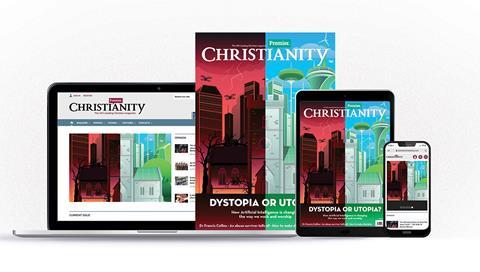Best known for his equine sculptures, Nic Fiddian Green opens up about his new, deeply personal work — a crucified Christ — and the journey of suffering, reflection and solitude it led him on

Nic Fiddian-Green is best recognised for his stately equine sculptures, positioned not just across the UK, but across the globe.
When we convened to discuss his latest work, it became very apparent, very quickly that this is not a man content with operating at the surface — either in his art or conversation. “I don’t want to talk about the weather,” he told me. “Tell me how you feel.”
That part of his makeup may be responsible for his shift in focus from monumental horse heads that established his name in British contemporary art, to The Face of Christ — a deeply personal and spiritual project, modelling the crucified Christ.
The resulting work is the culmination of Nic’s journey into self: confronting the face of Christ and an isolation-induced reflection on the suffering, faith and trials that have shaped his own life.

You’re renowned for your equine sculptures. What led you to shift the focus to Christ?
I married 33 years ago, and we went to live on a little island off Malta called Gozo, which is a very devout Christian society, founded on the shipwreck of St. Paul, as in the New Testament, where he ended up converting the islands of Malta.
We went to live there, and Henrietta and I started our married life — it ultimately began in a very traditional Catholic, but fundamentally Christian society. It led me to be moved, inspired, and I started some work as a sculptor. I kind of entered into the question of Christ.
The question was: what did he look like? I found myself inspired to start the search for that image. I work in clay. I started modelling in the old-fashioned sense and began work around trying to search out the mystery of Christ’s face.
You’ve faced more than one life threatening illness, how did they shape the faith that inspired this sculpture?
That’s a good question—I don’t know the answer. I don’t really know why I lived. There were many men and women in the Royal Marsden when I had cancer, and some of them didn’t make it. I don’t know why I survived. But I guess that’s God’s business.
Sometimes I need to stop and remind myself that life is a miraculous adventure. I think I need to draw from that well more often. That’s probably what I took away from facing three life-threatening illnesses: abdominal cancer, leukaemia, a brain tumour—and then alcoholism, which was the hardest to recover from.
I’ve been sober seven years now, and that’s a miracle in itself.
I probably should have died. I came very close at the end of my addiction, just like so many others. It’s part of my story. I don’t know if it’s relevant, but it was a tough battle. You’ll know plenty of people who struggle with addiction—it’s everywhere. Every street, every bar, every town. It’s life’s great temptation. It’s a way out.
I had the miracle of being able to put the drink down. People ask how I did it. And I say: “I don’t know.” But somehow, God got in the way. He stopped me at some point on that dark road and said, “It’s time. It’s time for you to stop. It’s time to get well again.” And I did.
Could you talk me through the actual process?
Yeah, well, it is literally a bag of clay. I was looking at references that have been used for centuries: other artists and their approach, their discoveries, their inspirations, their understanding, their finding Christ in their paint.
I’m looking at it thinking: what is it about an image that can move one? Starting with a sculptor’s experience or a sculptor’s expression — it’s always been our question. I suppose it moves into the question of God.
It’s the eternal question. People have constructed ideas, religions have been born out of this understanding and belief system. But what was the face of Christ? What did he look like?
I suppose it then took me to the cross. It took me to the place where I could kind of understand a bit about the suffering of Christ — Christ the man, Christ tortured.
And I suppose, as a believer myself, I wanted to know more. Because I’m a sculptor, it means for me my way of expressing that had to be in three dimensions. It has to be using clay initially — soft material, carefully articulated and controlled.
Focusing in specifically on the face, and focusing in on that point where he is at the end of his life on the cross. He’s looking down at mankind beneath him. Is it in that position where he forgave us all?
So we enter into that great mystery of understanding the belief system — that he died for us. If the story, as we believe, is true, then what was going on in his mind in that moment? And I suppose that’s what artists for 2,000 years have been trying to wrestle with.
And then we’ve got our own experience. And I think this is what brings me back to humanity. He lived a life, he travelled, he felt, he ate with us, he talked to us, he preached to us. He performed miracles for us. He lived with us. And then he was put to death for us. And we just stood around. We just are left with the question of, what am I going to do about it? What is my part in this great story of life?
Do you feel like the sculpture is part of your answer to that?
I’ll tell you what happens. I worked on this piece for about a year, on and off. But I’ve struggled with it as I worked on it. I went through various questions. I didn’t quite know where I was going.
It’s a crucifixion. We kind of know — the arms are stretched out. It’s figurative, it’s lifelike, it’s based on kind of old, traditional ways and styles. I’m not trying to make something modern and weird or difficult or plastic. I’m making something out of clay and plaster. I’m turning it into bronze.
And what’s happening is people are coming by and they’re knocking on my door and saying, “What are you up to?” And I ask them in, and I say, “Come and have a look at this.” I didn’t know who they were. I’d sit them down in a chair in front of it, and I’d say, “What is it that you see in what I’m doing?”
Probably 40 people came in and out over the period, and 99 per cent of the people came up with one word, which I thought was very interesting. The word was acceptance.
That’s my experience. I think Christ was saying, probably, “Listen — you’re all accepted the way you are.” Yeah. And even when you get it wrong, that’s okay.
And what it is simply about is the ability to accept each of us as we are.
I’m not there to convert. I’m just there to say: “There he is. And what do you find?”
Is that what you hope people will draw from encountering the sculpture, Christ’s acceptance?
I don’t really know what I’m hoping for. It’s a tricky one. Look — I’m a contemporary sculptor, right? I make horse’s heads for a living and for a love. It’s what I’ve done all my life.
And when I put together a show like this, which I’ve never done before… I take a few ideas about my interpretation of the face of Christ to the middle of the capital, to the West End of London city. And I hang these pieces in a beautiful gallery. And I dim the lights. I’ve told them to take out all natural light. I cool it right down. We may even light a candle.
And those passersby on the street, going between — I don’t know — buying a loaf of bread or a little bit of shopping coming to see what’s inside through that door…What do I hope they see?
Maybe they find some truth in themselves. Maybe there’s a truth here that I can’t really expect them to find.
I think if there is something moving — if Christ moves in the mysterious way that I believe he does — if they can be touched, moved, or maybe just curious. Maybe they just might even open the door to their own questions.
Because not everyone’s a believer. London — we’re a multi-national, racial and religious society. That’s the greatest thing about London, its openness to everyone.
Put a Christian in front of Christ, these images — well, that’s quite easy. But what about the non-believers? What about the others?
I’m not there to convert. I’m just there to say: “There he is. And what do you find?”
Would you say that this process was uncomfortable?
Yeah, I would, actually.
Why?
You get up in the morning quite early, go up to the cold shed, open the door in sometimes below-zero temperatures — and confront Christ. I mean, is that your ideal way to start the day?
It’s easy to wrestle inside the mind and say, “Well, maybe I’ll just stay in bed a little longer,” and, “Well, maybe I’ll just take the dogs for a walk.” You know, everything to avoid going into that cold shed and confronting Christ and the question of: how am I going to find him?
And in seeking the face of Christ as you created the sculpture, what did you find?
I found that through pushing myself into the uncomfortable place, I kind of started to reveal more of myself, but more of Christ was beginning to reveal himself through that.
I think what he’s saying is: “be brave.”
It’s back to the question of “Follow me,” isn’t it? It’s much easier not to.
And when he said to the fishermen, “Leave your nets behind,” he’s basically saying to us all, “Come on. What do you really need?”
And the answer is: we don’t need a lot.
Maybe a roof over your head — but you could always take a bit of canvas, you know, find a bit of… create a little fire, you know. Maybe a bit of a corner of a bit of old cheese is in your pocket from the day before. And then someone passes by and hands you a bit of bread, and you sit down, you share the bread — and next thing you know, you’re living.
What was the hardest part of creating this sculpture? It sounds like it involved a lot of reflection—revisiting the alcoholism and the laughter, the pain and the joy.
I think the hardest part was getting honest with myself while confronting the work. That’s tough. It’s easier to take shortcuts, to find the easy way out. But when I’m sitting there alone with the work, I’m alone with myself—and that’s not always comfortable.
In being alone throughout this process, have you grown in that environment?
Yes. It takes time. You tell me the artist who can sit quietly for 12 hours, carving or composing, without picking up the phone to call someone—I don’t know any. I find it hard myself. But it’s something you learn.
The longer you practise the art of being, the discipline of working in silence, the serenity you need to express yourself honestly—that takes time. I’ve been doing it for a while now. I’m okay with the cold, I’m okay with the sun.
That’s taken time. It’s all part of the journey. The journey of discovery. Of revelation. Of things being revealed you never knew were possible. That’s the wonder of true art. Brave artists take risks—they push themselves. I’m not great at that. But the risk-takers—those are the ones who change things.
Do you see The Face of Christ as a one-time project? Or will you continue to explore Christ-based themes?
You’d have to ask God. [chuckles]
That’s a great answer.
I mean, it’s a privilege. What I do tomorrow will be different from today. And the day after, different again. I’m not much of a planner. I prefer to feel the wind and work with the rhythms of nature, the seasons, family, and friends.
Yes, I’ve got bills to pay. Yes, I have to show up and give a bit of myself when maybe I don’t want to. But I try. Not always well—but I do my best.
In making this sculpture of Christ, and now sharing it with the public in the centre of London, how do you feel? Pride? Nervousness? What emotions come up?
It’s scary. I mean—who am I? There’s a part of me that has to stand in front of this thing and profess my faith. Am I really accountable? Can I stand and say, “I believe”? That’s going to be difficult.
In terms of the quality of the work, I’m okay. I’ve worked with amazing people—technicians and artisans. I want people to see it’s an ancient material, bronze, and we’ve worked at the highest level we can. The quality of the craftsmanship is phenomenal and I’m proud of that. Yes, I see the flaws—but I’m hard on myself. It’s never quite good enough, but that’s okay. That’s something I wrestle with.
I’m nervous. I worry no one will come. But the work is done. I can’t relive the process. I’ve got to remember: it was a privilege to make this. That time spent trying to find the face of Christ was a gift.
And do you feel like you’ve found it?
No.
But maybe I’ve caught a glimpse of his feelings. That he didn’t judge. That he said to each of us, “I get it.” That we’re all sinners—and therefore who are we to judge anyone else? He said, “I’m not going to judge you. I’ll accept you as you are.”
That’s freeing. And I think there’s a bit of that in this piece.
I don’t know if it’s fully revealed.
I don’t know if I’ve expressed it well enough.
But I’m okay with it.
I think I’ll sleep quite well tonight. And that’s good enough.
The Face of Christ exhibit is open at Sladmore Gallery, London until 9 May







































No comments yet